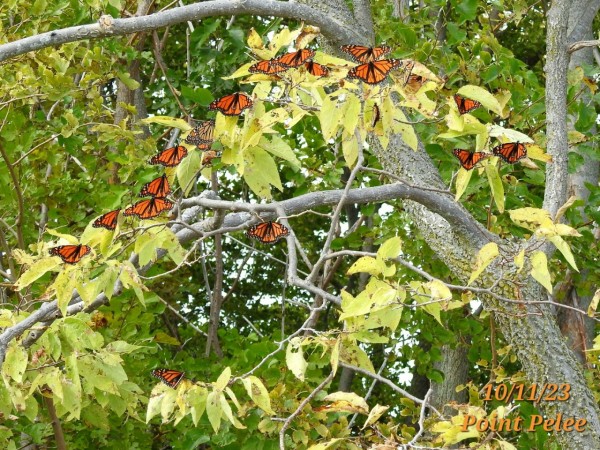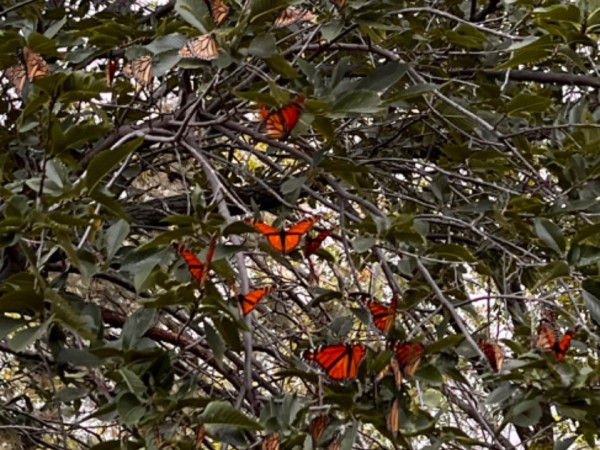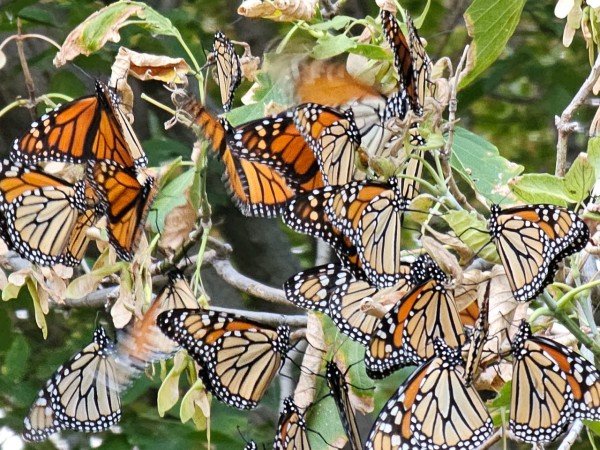Roosting Data
Key information for conservation and for solving a great mystery of the monarch migration.
Patrick A. Guerra, a neuroscientist and urban ecologist, explains how the contributions of community scientists in participatory science projects, such as Journey North, can help us answer the ultimate question in monarch butterfly migratory biology: How do monarchs find their overwintering sites?
The Role of Observation Records for Understanding Monarch Roosts
One of the great mysteries of the annual, multigenerational monarch butterfly migration is how fall migrants find their overwintering sites. This mystery is particularly intriguing since these butterflies are on their maiden voyage to a handful of specific locations that they have never been to before. For example, although it is known where fall monarchs can overwinter and how monarchs use various innate internal compasses to guide them to these places (for example, eastern monarchs can use sun and magnetic compasses to find their way to central Mexico), it remains unknown how fall migrants ultimately recognize and stop at their overwintering sites.
One possible explanation for how monarchs find their overwintering sites is that they are looking for specific microhabitats found at these locations. These microhabitats are neither too hot nor too cold and can buffer monarchs from harsh environmental conditions, thereby allowing them to survive the months-long overwintering period before they return northwards in the spring. Fall monarchs are potentially finding the overwintering sites via environmental cues or indicators consistent with these microhabitats. Here, these beneficial microhabitats are most likely produced by key vegetation at the overwintering sites: trees with specific canopy, branch, and leaf topography, that optimize environmental conditions for the monarchs that end up hanging on them all huddled together, at times numbering in the millions.
Curiously, prior to arriving and aggregating at their overwintering sites, fall migrants do something very similar during the trip south. Fall monarchs will form roosts where they rest together for the night, before continuing their migratory journey the next day. Although it is also still unclear how monarchs decide where to form roosts, these roost sites (most often on trees) perform a similar function as the overwintering sites, as these stopover sites provide nightly refuge against the cooler conditions of fall. As the overwintering colonies of monarchs are essentially long-term roosts, understanding roost formation during southward migration is potentially the key to unlocking the mystery of how fall migrants form and maintain their overwintering colonies.
Currently, Journey North, the National Wildlife Federation, and my research team are identifying the features of fall monarch roosts and defining the environmental cues and conditions that facilitate roost formation. The observations of roosts made by participatory scientists and submitted to programs such as Journey North are crucial for conducting this research, as observations of fall monarch roosts across North America provide invaluable information. Given the key function of roosts, observations delineating where and when roosts are formed, e.g., which tree species and the characteristics of these trees, can assist efforts aimed at preserving the iconic long-distance migratory phenomenon of monarchs. Moreover, knowing which types of trees are used by monarchs can help with conservation and habitat restoration efforts, which can mitigate the effects of habitat fragmentation and degradation along the migratory pathways of monarchs. An additional benefit of preserving and creating roost habitats for monarchs is that these habitats can also serve the habitat needs of other species, particularly in heavily urbanized areas that are experiencing significant development and shifts in land use. Finally, knowing how roosts are formed can produce testable hypotheses for studies that determine where and how overwintering colonies are established. Information from this work can then be used to more efficiently preserve habitats and locations that are targeted by migratory monarchs for overwintering.
---
Patrick A. Guerra, PhD, is a neuroscientist and urban ecologist who has been studying monarch butterfly migration and sensory ecology since 2010. His research with monarchs has shown that contemporary environmental stressors such as climate change and urbanization threaten the migratory capabilities of monarchs since these stressors directly affect the navigational mechanisms that monarchs use during their long-distance journeys. Along with his scientific research, Patrick is involved in STEM outreach and conservation initiatives aimed at protecting pollinator species. Patrick has been a featured scientist in popular science media such as in the book ‘The Language of Butterflies’ by Wendy Williams (Simon & Shuster, 2020) and in the Emmy-nominated TV series ‘Jane’ (Episode 7 – Danaus plexippus), co-produced by Apple TV+ and the Jane Goodall Institute. For more information, please visit www.patrickguerra.com.



